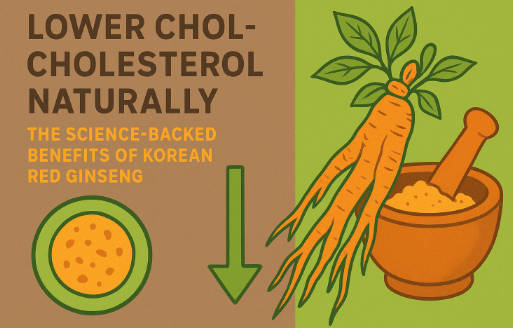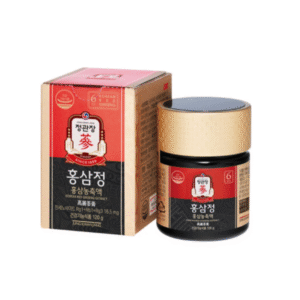Introduction: The Modern Challenge of High Cholesterol
High cholesterol has become one of the most common health issues of modern life. Sedentary lifestyles, processed diets, and chronic stress all contribute to elevated LDL (bad cholesterol) and triglycerides, leading to plaque buildup in arteries — a primary risk factor for heart disease and stroke.
While medications like statins remain the gold standard for managing cholesterol, more people are seeking natural, science-backed alternatives that promote balance without harsh side effects.
One of the most researched herbal options is Korean Red Ginseng (Panax ginseng Meyer) — a traditional Korean root renowned for improving cardiovascular health, energy, and longevity.
1. Understanding Cholesterol: The Good, the Bad, and the Balance
Cholesterol isn’t inherently harmful. Your body needs it to build hormones, vitamin D, and cell membranes.
However, the imbalance — too much LDL (low-density lipoprotein) and too little HDL (high-density lipoprotein) — can cause arterial plaque buildup, increasing the risk of atherosclerosis, heart attack, and stroke.
The goal is not to eliminate cholesterol, but to restore healthy balance, reduce oxidative damage, and improve lipid metabolism.
That’s where Korean Red Ginseng can make a difference.
2. How Korean Red Ginseng Helps Regulate Cholesterol
Korean Red Ginseng works on multiple physiological pathways to support healthy lipid metabolism.
Research shows that ginsenosides, its primary bioactive compounds, can:
- Lower LDL and total cholesterol
- Increase HDL (good cholesterol)
- Reduce triglycerides
- Inhibit lipid oxidation (which causes plaque formation)
A 2020 study in the Journal of Ginseng Research found that daily supplementation with Korean Red Ginseng significantly reduced LDL cholesterol and improved arterial elasticity in participants with mild hyperlipidemia.
[Source]
3. Ginsenosides: The Heart-Healthy Compounds
The power of Korean Red Ginseng lies in its ginsenosides — a group of natural saponins with wide-ranging effects on metabolism and inflammation.
Specific types, such as Rg1, Rb1, and Rg3, play key roles in lipid regulation by:
- Enhancing liver fat metabolism, preventing fatty liver and cholesterol buildup
- Inhibiting HMG-CoA reductase, the same enzyme targeted by statin drugs
- Boosting antioxidant defenses, reducing oxidized LDL (ox-LDL) — the most dangerous form of cholesterol
These mechanisms not only balance cholesterol levels but also protect arterial walls from oxidative stress and inflammation.
4. Reducing Oxidative Stress and Arterial Plaque
Oxidative stress contributes to the oxidation of LDL particles — a critical step in plaque formation.
Korean Red Ginseng acts as a potent antioxidant, neutralizing free radicals and improving blood vessel integrity.
In a 2021 animal study, ginseng extract reduced plaque formation and improved endothelial function (the ability of blood vessels to relax and contract properly).
This suggests that KRG may not just reduce cholesterol numbers but also improve the functional health of arteries — a deeper level of cardiovascular protection.
[Source]
5. Improving Lipid Metabolism and Energy Balance
Another way Korean Red Ginseng supports healthy cholesterol is by enhancing cellular energy metabolism.
Ginsenosides activate AMP-activated protein kinase (AMPK) — an enzyme that promotes fat burning and reduces lipid synthesis.
By improving fat utilization for energy, KRG helps maintain a healthy body composition and prevents excess cholesterol accumulation in the bloodstream.
This makes it particularly helpful for individuals with metabolic syndrome or insulin resistance, where cholesterol and triglyceride levels are often elevated together.
6. Synergistic Benefits: Blood Pressure and Circulation
High cholesterol rarely acts alone — it’s often accompanied by high blood pressure, inflammation, and poor circulation.
Korean Red Ginseng supports these interconnected systems by:
- Improving nitric oxide production, enhancing blood flow
- Reducing vascular stiffness
- Lowering C-reactive protein (CRP) — a marker of inflammation linked to heart disease
This holistic approach makes KRG a multifunctional cardiovascular adaptogen — improving the entire heart–vessel network rather than targeting one symptom.
7. Clinical Use and Dosage
Recommended dosage:
- 400–1000 mg/day of standardized Korean Red Ginseng extract (containing 3–5% ginsenosides)
- Duration: At least 8–12 weeks for measurable cholesterol improvements
Forms available:
- Capsules or tablets
- Ginseng tea or liquid extract
- Concentrated powder for smoothies or soups
Best taken:
In the morning or before exercise to enhance circulation and metabolism.
8. Safety and Precautions
Korean Red Ginseng is generally safe and well-tolerated.
However:
- Consult your physician if you’re taking statins or blood-thinning medications.
- Avoid taking it late in the day to prevent mild insomnia due to energy-boosting effects.
- Pregnant or breastfeeding women should use only under professional guidance.
Choose only authentic, certified Korean Red Ginseng products for optimal purity and potency.
9. The Takeaway: Nature’s Root for Modern Heart Health
In a world where cardiovascular disease remains the number one killer, Korean Red Ginseng offers a time-tested, scientifically validated natural ally.
By helping to lower LDL, raise HDL, improve circulation, and reduce oxidative stress, this remarkable herb supports the body’s natural cholesterol balance — the holistic way.
Combining modern science with ancient wisdom, Korean Red Ginseng stands as a powerful natural strategy for lifelong heart and vascular health.
🇰🇷 Premium Korean Ginseng Online Shop







